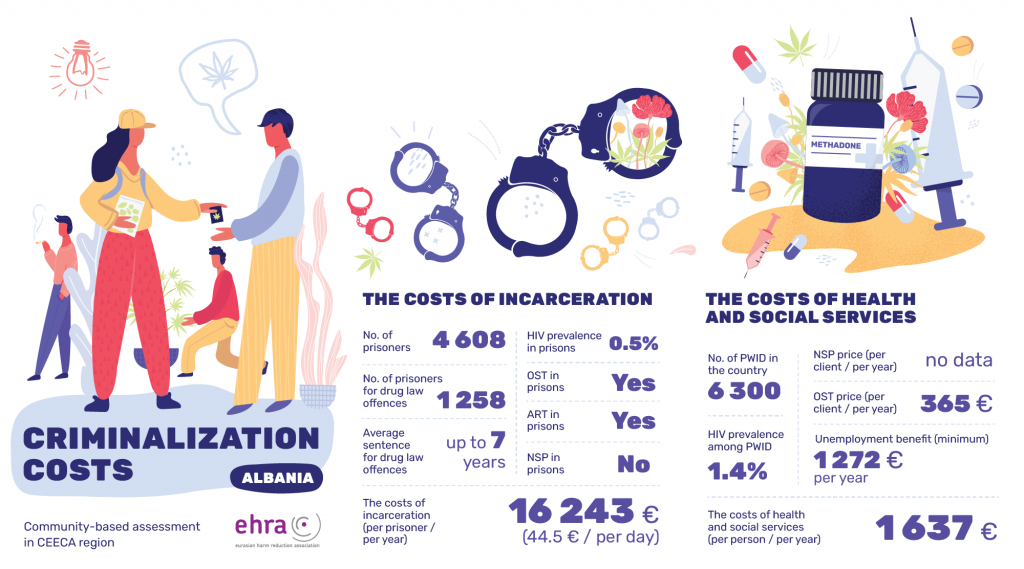According to the General Directorate of Prisons, there were 4,608 people in prison as of January 2021 of which 1,258 (27%) were incarcerated for drug law offences, including pre-trial detainees [1]; conviction for drug law offences can carry a sentence of up to seven (7) years imprisonment [2]. Prevalence of HIV among prisoners in Albania was reported as 0.5% in 2019 [3] and coverage of antiretroviral therapy (ART) at 8% according to programme data reported by UNAIDS [4], [5]. Opioid substitution therapy (OST) is available in Albanian prisons with services provided by national partners upon request of prison authorities, with 34 prisoners reported to be receiving methadone in 2017 [6]. However, there are no needle/syringe programmes (NSP) operational in prisons [7].
An average of €16,243 per year was spent on detaining each inmate in 2019, the equivalent of €44.50 per inmate, per day [8].
There are an estimated 6,300 problematic drug users in Albania with an HIV prevalence of 1.4% [9]. There is no data on the costs of NSP. OST costs approximately €1.00 per person, per day, or €365.00 per person, per year[10]. Unemployment benefit paid by the state is €1,272 per person, per year, or €106 per person, per month [11].
Therefore, the estimated total cost to the Albanian state of one person detained in prison is €16,243 per year, or €1,354 per month. This compares with €1,637 per year, or €136 per month, for each person who uses drugs and lives in the community.
Consequently, it is ten (10) times more costly [12] for the Albanian government to keep a person who uses drugs in prison per year than to provide support to such a person in community settings, i.e. an additional €14,606 is spent by the government of Albania to imprison each drug user than it costs them to assist the same person in their own community. Therefore, the decriminalization of drug use could save the Albanian government up to an estimated €18.4 million each year, based on 1,258 people incarcerated for drug law offences as of January 2021.
[1] General Directorate of Prisons. Statistical data of the prison system – January 2021. Tiranë; General Directorate of Prisons. http://www.dpbsh.gov.al/newweb/?fq=brenda&m=shfaqart&gj=gj1&aid=876 (accessed 3 August 2021).
[2] European Monitoring Centre for Drugs and Drug Addiction (EMCDDA). Albania, National Drug Report 2017. Luxembourg; Publications Office of the European Union, 2017. https://www.emcdda.europa.eu/system/files/publications/4700/National%20drug%20report_Albania.pdf (accessed 3 August 2021).
[3] Joint United Nations Programme on HIV and AIDS (UNAIDS). Country factsheets, Albania. Geneva; UNAIDS, 2020. https://www.unaids.org/en/regionscountries/countries/albania (accessed 3 August 2021).
[4] Council of Europe. Response of the Albanian Government to the report of the European Committee for the Prevention of Torture and Inhuman or Degrading Treatment or Punishment (CPT) on its visit to Albania from 20 to 30 November 2018. Strasbourg; Council of Europe, 27 February 2020. https://rm.coe.int/16809cb571 (accessed 3 August 2021).
[5] UNAIDS, Country factsheets, Albania, Ibid.
[6] Stöver H, Teltzrow R (eds.). Drug-Treatment Systems in Prisons in Eastern and South-East Europe. Strasbourg; Council of Europe, June 2017. https://www.emcdda.europa.eu/system/files/attachments/5502/Drug-treatment_systems_in_prisons_in_Eastern_and_South-East_Europe.pdf (accessed 3 August 2021).
[7] Harm Reduction International (HRI). Global State of Harm Reduction 2020, Regional Overview 2.2 Eurasia. London; HRI, 2021. https://www.hri.global/files/2020/10/26/Global_State_HRI_2020_2_2_Eurasia_FA_WEB.pdf (accessed 3 August 2021).
[8] Aebi M F, Tiago MM. SPACE I – 2020 – Council of Europe Annual Penal Statistics: Prison populations. Strasbourg; Council of Europe, 2021. https://wp.unil.ch/space/files/2021/04/210330_FinalReport_SPACE_I_2020.pdf (accessed 3 August 2021).
[9] UNAIDS, Country factsheets, Albania, Op.cit.
[10] The information is estimated and provided by national partner in Albania.
[11] Albanian Lek 13,000 converted to Euros as of 12 July 2021, http://www.instat.gov.al/en/themes/social-condition/social-protection/#tab2 and, http://databaza.instat.gov.al/pxweb/en/DST/START__SS/SS0007/table/tableViewLayout2/?rxid=7776afdf-a06b-460f-9285-7da080cb5718
[12] NSP costs are not included, as there is no data on it.

